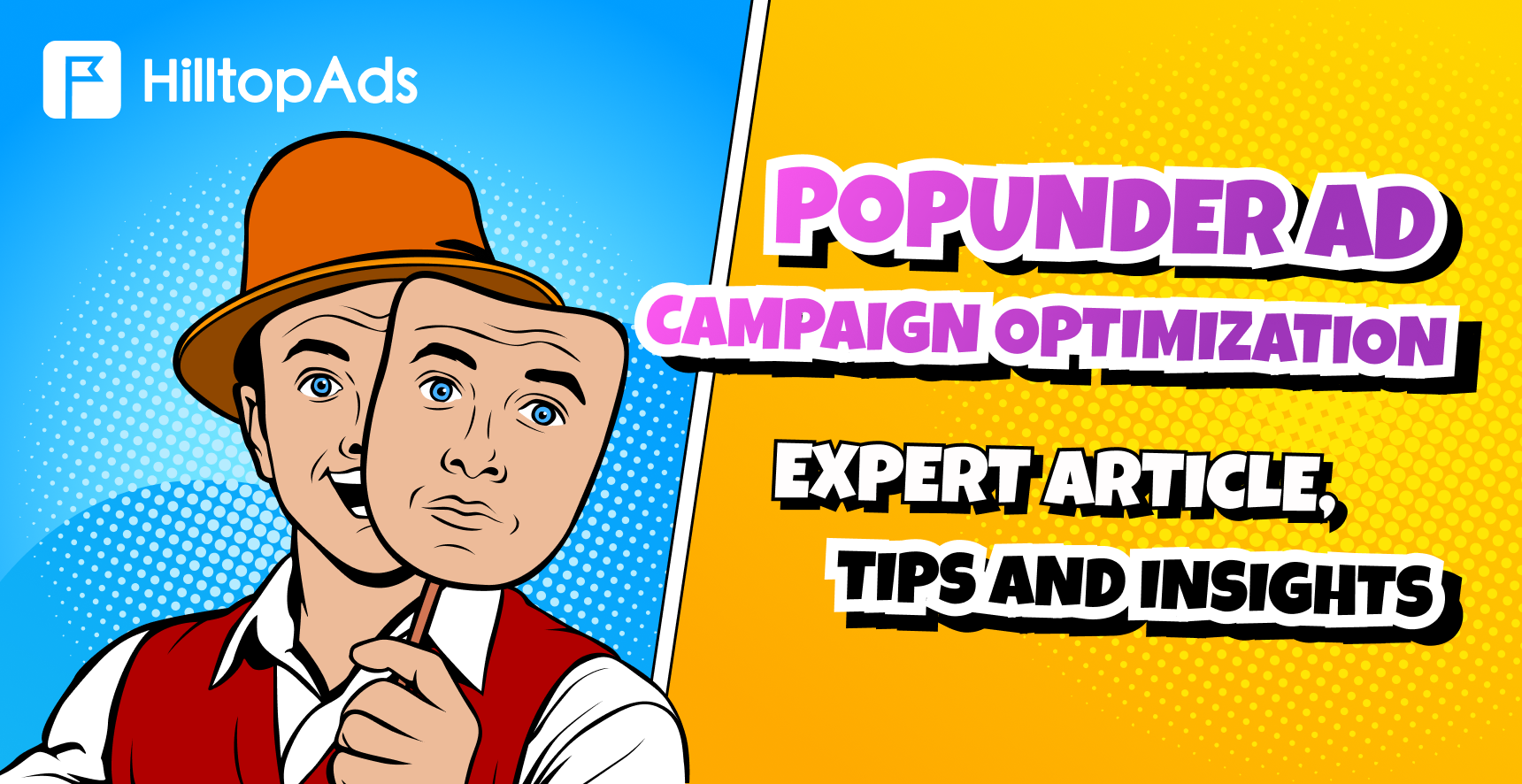Where does ad campaign optimization begin? How is improving Popunder’s campaign performance different from the optimization process in general? What pitfalls might you step in at various stages? We resolve all the possible questions you might have by providing the biggest manual on Popunder campaign optimization.
Because this article will directly address Popunder traffic, we should mention that the effective way of optimizing such campaigns combines solid methods (the ones you can apply to optimize all sorts of ad campaigns) with techniques tailored specifically to Popunder. But in both cases, optimization serves one goal – maximizing ad revenue. And we can distinguish three major parameters you can affect on:
- Bot & Fraud activity;
- Budget;
- Targeted traffic.
There are numerous ways to influence them, and each approach requires expertise to know when and how to be applied. Therefore, it’s essential to investigate each stage separately, and that’s exactly what we’ll do next.
When it’s time to Optimize?
Before we discuss the details of optimization, we need to understand when the process should be initiated. It’s important not to jump the gun and collect enough data before adjusting an ad campaign. Usually, it takes 2-4 days to get enough traffic to run through and start analyzing ad campaign performance afterwards.
Note: we recommend you launch tests using all traffic sources and zones turned on (expand your audience reach as big as possible, collect zones in Whitelists &Blacklists).
Stages
The optimization process will have much more impact if it is structured and organized. While affiliates can choose various paths, we will share the one that our advertising managers found most effective.
1. Getting ready
With the proper preparation, you can significantly reduce the work (and time) required to optimize the ad campaign further.
- Check out the most attractive offers from affiliate programs, CPA networks, etc. Select 1 to 3 offers with an easy flow to begin with.
- Learn all about chosen offers (geos where the product is available, recommended targetings: devices, OS, languages, etc.)
2. Budget
First, you must distribute the budget between the test period and the main launch. For tests, you can allocate payment from around $50 or follow the rule that the budget should be equal double the CPA’s cost if it’s an easy offer, and it can be five times bigger if the offer requires high engagement from user (KYC, deposit, etc.). The rest of your advertising money should be spent on scaling up the most profitable segments and targetings.
The recommended minimum for running tests in different niches:
| Vertical | Tests Budget |
| Сrypto | $2000 |
| Finance | $2000 |
| iGaming | $2000-$5000 |
| Software | $500 |
| Dating | $500-$1000 |
| Games | $500 |
| Nutrition | $1000 |
| Sweepstakes | $500 |
| PinSubmit | $300 |
| Webcam | $500-$1000 |
Another important advice is that the ad budget must always be positive and put on the balance in advance, so your ad campaigns never stop traffic flow. Going back to effective zones will be much harder than strategically planning all expenses.
Potential Pitfalls
Funds assigned to tests are too small.
Solution: One ad campaign’s traffic volume should be around 50,000 impressions. Calculate what sum it will take to run such volumes depending on your rates.
“Burned budget”
Solution: to avoid unnecessary spending, all you need is to analyze the performance of the ad campaign and optimize it in time.
3. Optimization by zones
Next, we recommend eliminating non-effective zones. This requires removing zones that don’t bring conversions or do it too expensively, as well as combining profitable ones into whitelists.
At this stage, the postback tracking must be set up to pass accurate data about conversions to HilltopAds statistics.
Please be informed: At HilltopAds, we have an integration with all well-known trackers such as Bemob, Keitaro, AdsBridge, AppsFlyer, Voluum, Redtrack, Binom, Peerclick, and Skro. Here is a section about setting up Postback.
How to understand that a zone should be added to a Blacklist:
- If you spent on a zone about 80-130% of the CPA payout without generating a conversion;
- If there are three or more conversions with a cost higher than about 50% of the CPA payout;
Note: You can use HilltopAds autorules to make this process easier. We provide more info about the advantages of auto-optimization with our platform further.
What metrics to look at this stage:
Number of conversions
The number of conversions according to Zone ID and Sub-ID tokens will tell you whether the zone should be added to BlackLists or Whitelists.
High ROI Zones
Identify high-ROI zones for relaunching in separate campaigns while keeping the RON campaign active as a donor campaign.
User Engagement
Evaluate user engagement metrics: CTR, Bounce Rate, and Time on the site.
Fraud Activity
Always check zones for non-common activities (e.g., fraud).
Bid Rate
If some zones provide small portions of traffic – check that your bid is competitive in the auction. After you receive enough traffic – evaluate its performance based on the abovementioned metrics.
Potential Pitfalls
Take into account the type of offer / niche you’re working with.
For instance, in iGaming and Pin-Submit verticals, conversions can cost more than payouts, but they will be compensated in the long run because affiliates will keep earning for players’ redeposits in the future. It also might be the case that some users save information about your offer the moment they see advertising, but the targeted action will be completed later. For example, a new player signed up for your online casino right after engaging in an ad, but the first deposit was made a few days later. This is why you must consider such delayed conversions as well, and don’t hurry up to turn off the ad campaign in case it doesn’t look as profitable as you wish it to be at first sight.
Verify that there is no malicious activity.
Solution: use pro-trackers with ani-fraud filters.
Not enough data is received during the test period.
Solution: increase the ad budget and the bid.
Incorrect Postback operation.
Solution: As optimization by zones is one of the first stages, your tracking might not be set up properly. Therefore, it won’t hurt to double-check that everything works correctly.
Don’t speed up to add zones that associate with small volumes of traffic to the Blacklist.
Solution: consider each zone individually and implement changes based on their performance not just over time but, most importantly, over essential traffic volumes.
4. Optimization by traffic segments
Great! Now, you have zones that provide the most conversions, with costs within the payout range. Let’s optimize these zones by segments of each traffic source.
Expert Tip: Even though High activity segments bring you higher chances for conversions, you can also run tests through Low segments to find sources that will bring you more leads at lower cost.
5. Optimization by targetings
Perfect! You have found the cream of the crop for your ad campaign. But we can increase your CTR even more by optimizing each segment’s targetings.
You should check the stats for the main settings and turn off the less effective ones.
The key targetings to optimize here are:
- GEOs;
- Devices;
- OS and its versions;
- Browsers and its versions;
- Languages;
- Connection type;
- Campaign schedule;
- Keywords, interests.
As a result, we can study the costs associated with individual segments and targetings to capture only those conversions that give us a lower eCPA. This increases the effectiveness of the whole ad campaign and the revenue generated with it.
Expert tip: You can also scale up profitable targeting setups (e.g., mobile devices + Safari + iOS v18 + 14-16 PM) by increasing bids for such ad campaigns.
Potential Pitfalls
Not knowing target audience.
Solution: As we mentioned earlier, researching focus groups is a must to save time and money. One way of doing this is to read an offer’s description. Often, you’ll find information about the OS, browsers, language, and GEOs of the target audience.
Ensure ads are displaying correctly
Solution: Check how advertising is shown at chosen targetings. For that, follow the link to the landing / offer page and ensure the design is intuitive and easy to follow.
Browser language
Solution: Don’t forget about language targeting, as it can save your budget from being spent on showing ads to an audience that doesn’t understand anything about your promo materials.
Offer’s main page is ready to accept targeted traffic
Solution: However, the offer sometimes doesn’t accept traffic from certain targetings. Make sure your targeting setup aligns with the product’s policy. For example, if you promote a mobile app offer that operates only on iOS devices, but in targeting, you select Android devices as well.
Too narrow targetings
Solution: selecting more than necessary targeting settings simultaneously can result in smaller traffic matching requirements. It can also lead to a much higher bid than expected.
Note: This is one of the most common mistakes advertisers make. Read “Top 10 Affiliates Mistakes You Don’t Know About” to learn more.
5. Promo-materials optimization
We’ve almost reached the final step of popunder campaign optimization. Before that, we also need to verify that the creatives and pre- / landing pages you use to promote the offer are fine-tuned and in the best shape to convert views into sales.
So, what can you do to increase CTR of promo materials:
- Run A/B tests: See how the audience reacts to different titles, hooks, promises, CTAs, color palettes, and even the language you use.
- Loading speed is fast: The page or creative should take no longer than a second to be loaded.
- Analyze user behavior for different ad campaigns: Time spent on the page, session duration, and bounce rate.
- Promo materials are optimized for all targeted devices.
- Intuitive design: Users can quickly figure out what the advertiser has to offer and what the targeted action is.
- No fraud activity is hidden: Check pre- / landing page URLs and redirects between different ad funnel stages for viruses. Of course, there should be none of such.
- Banner blindness: There could be multiple reasons for that. For example, if you use the same creatives for a long time, the audience might get used to it and stop engaging. Or another reference, when your promos are simply bad: they don’t reflect the USP, users see that this is the ad. Keep that in mind, and optimize if necessary.
- Contact your personal manager: Ask a personal manager on the platform for some references of what’s converting in similar ad campaigns right now (or you can use popular spy tools to complete this research by yourself).
- The power of pre-lander: Don’t forget to add prelander to promote your offer. Using such with Popunder ad format is essential since it counts as your ad view for all clients instead of creatives.
Potential Pitfalls
Incorrect display of landing page for some devices & OS.
Solution: optimize visuals for different mobile screens and desktops.
Slow landing page loadspeed can lead to visitor loss, even before the page is shown.
Solution: Check the loading speed using specialized tools (like https://pagespeed.web.dev/). The milestone is a load time of under one second and a page size of less than 200 kilobytes.
Landing page or creative mislead target audience.
– Advertisers rushed to craft landing and creatives instead of taking enough time to learn more about the offer. As a result, promo materials don’t reflect the USP of the offer.
– The landing page design is not easy to understand and is overfilled with different bright and big elements, confusing potential leads.
– Advertisers intentionally provide misleading information about the product, promising impossible results and strictly lying to clients. It might lead to chargebacks.
– The information about the product is outdated. If you promote an offer for a long time, keep an eye on the relevance of the information you put on the landing page to be sure that the audience’s expectation meets what they find on the main page.
Solution: spend enough time to prepare decent promo materials (read guides, spy on competitors, ask your colleagues for feedback), investigate everything about your product, and be in the loop of trends and changes in your niche.
Offer’s main page is ready to accept targeted traffic
Solution: However, the offer sometimes doesn’t accept traffic from certain targetings. Make sure your targeting setup aligns with the product’s policy. For example, if you promote a mobile app offer that operates only on iOS devices, but in targeting, you select Android devices as well.
Language Mismatch.
Solution: Comply the language you use in promos with the one chosen for targetings/understanding by the target audience of the offer. If you don’t know the language enough to complete a professional translation yourself, ask AI to make texts look more native.
Malicious Activity.
Again, verify that there are no viruses hidden in landing page redirects. Otherwise, the viralized URL may get blocked, and users won’t see the ad.
6. Bids Optimization
Last but not least, you can work with ad campaign performance at the bid level. Our goal is to find the balance between paying less and receiving more conversions. We prepared a few tips that could help you with that:
- Increase rates for zones where you have the biggest number of conversions;
- Use the highest rates for Whitelist ad campaigns (contact your personal manager to learn what is the highest bid would be or follow Premium CPM as a reference and adjust depending on the outcome);
- Track auction of bids and its changes over time, adapt cpm accordingly;
- Analyze targetings and complete changes in bids depending on the effectiveness of specific segments (e.g. top-performing days, hours when your ad campaign gets the most conversions);
Potential Pitfalls
Using Too Low or Too High CPM rates
Charging too low rates may result in tiny portions of traffic available and worsen your position in the queue for showing ads to the audience. On the contrary, setting up too high cpms can decrease the ROI (for obvious reasons, as your spending increases).
Solution: Monitor the auction and set up a bid depending on the situation.
Metrics that Matter
One of the advantages of Pops ads is that such campaigns are not deeply connected to clicks-related metrics (CPC, CTR). Instead, data is analyzed using conversion-based parameters, such as eCPA and CR. Experts are also evaluating eCPM. What else:
For beginners:
- CTR (Click Through Rate): CTR < 1% means your ad campaign requires correction at the targeting or promo-materials level. CTR > 10% but without conversions: high chances for fraud, bot traffic, or not targeted traffic.
- CR (Conversion Rate): CR<0.3%: issues associated with a landing page, offer page, or targetings.
- CPC/CPM (Cost Per Click / Cost per Thousand Impressions): Rates should be adjusted according to the market changes and your ad campaign analytics after tests.
- ROI (Return of Investments): ROI < 0%: optimize targetings, offer, and reduce budget spent.
For experts:
- eCPM (profit you made from 1,000 impressions): if eCPM is low, then probably the audience is not interested in your offer or the traffic you get is not targeted. Change landing page or targetings.
- LP CTR (Landing Page Click-Through Rate): LP CTR < 20% – test different designs and titles
- Time-to-conversion: If the period from first click to purchase (deposit) is too long (for Pops long means more than 15-20 minutes), you need to test alternative ad funnels and check targetings.
- Ad frequency: The benchmark will be 1-3 ads in 24 hours. If ads are shown more often and CTR/CR drops, banner blindness may be the cause.
- APRU (Average Revenue Per User): Helps you to assess the effectiveness of multiple ad campaign setups and find the most profitable ones.
Advanced tools for Campaign Optimization
Besides all the methods mentioned above, you can upgrade your optimization workflow with unique features of our platform, such as:
- CPA Goal: You run a CPM ad campaign, and it’s optimized for a specific CPA within a week.
- CPM+autorules: Your ad campaign will test traffic from all available zones, adding to Whitelist those that give you the required results.
Note: our advertising managers closely monitor the KPI of each advertiser.
Extra Tips & Tricks from our Experts
Conclusion
Still here? That was quite a long run, but we covered all you need to know about working with pops ad campaigns, from preparation and zone optimization to targeting and promo materials improvements. One thing that’s common for all stages is that they are all about paying close attention to details and gradually proceeding from one step to another. We recommend you save this manual for later so you won’t be desperately looking for it when the time comes. And, of course, nothing is better than practice for remembering information; therefore, go to your HilltopAds ad network personal account and try new techniques today!






















